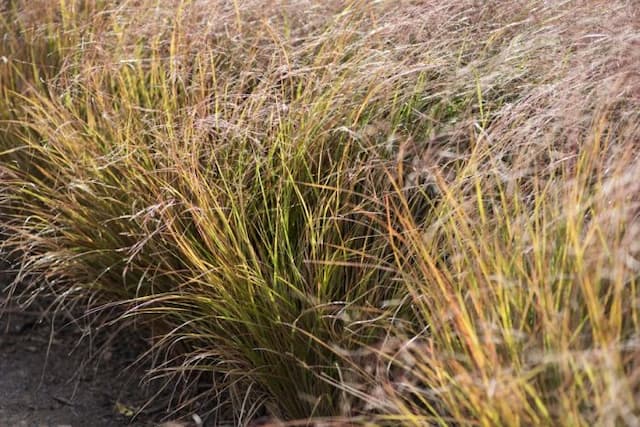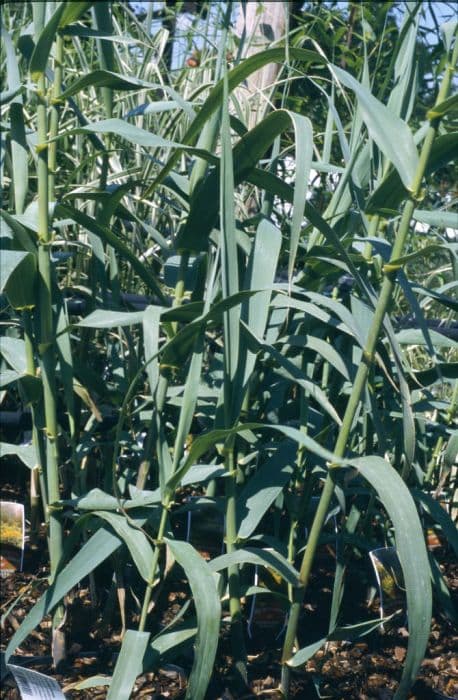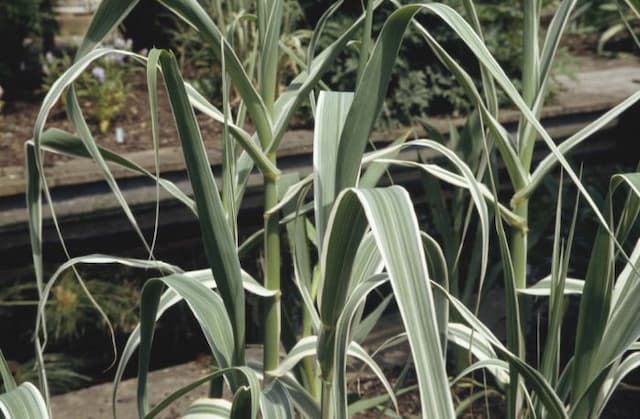Yellow groove bamboo Phyllostachys aureosulcata f. aureocaulis

ABOUT
The plant commonly known as the Yellow Groove Bamboo is distinguished by its striking bright green canes that possess a unique yellow stripe within the groove of each segment, lending the name to this eye-catching species. The canes, also called culms, have a smooth texture and a cylindrical shape, tapering slightly as they reach towards the sky. The groove's vivid yellow coloration contrasts beautifully with the surrounding green, making it quite distinctive in appearance. As the plant matures, some canes may take on a gentle arching form, giving the plant a graceful aesthetic. The leaves of Yellow Groove Bamboo are equally striking. They are narrow, elongated, and a rich green hue, creating a dense foliage that rustles in the wind. These leaves are attached to slender stems that branch off from the main canes. The appearance of Yellow Groove Bamboo adds both a tropical flair and a structured elegance to any landscape. Its alternating colors on the stems make it a focal point wherever it is planted, and the consistency of its leafy branches offers a lush, full-bodied look throughout the year.
About this plant
 Names
NamesFamily
Poaceae
Synonyms
Yellow Groove Bamboo, Golden Crookstem Bamboo, Golden Groove Bamboo
Common names
Phyllostachys aureosulcata f. aureocaulis.
 Toxicity
ToxicityTo humans
The plant commonly known as Yellow Groove Bamboo (Phyllostachys aureosulcata f. aureocaulis) is not known to be toxic to humans. Therefore, ingesting parts of this plant typically does not lead to poisoning or adverse health effects. However, as with any plant, individual allergies or sensitivities can occur, resulting in mild irritation or discomfort.
To pets
Yellow Groove Bamboo is also not considered toxic to pets. Ingesting parts of this bamboo should not cause poisoning in animals such as cats and dogs. That being said, overconsumption of any non-food plant material can potentially cause gastrointestinal upset or blockage in pets, so it is advisable to monitor pets and prevent them from consuming large quantities of any plants, including this bamboo.
 Characteristics
CharacteristicsLife cycle
Perennials
Foliage type
Evergreen
Color of leaves
Green
Height
20 feet (6 meters)
Spread
10 feet (3 meters)
Plant type
Bamboo
Hardiness zones
5
Native area
China
Benefits
 General Benefits
General Benefits- Landscape Beautification: Phyllostachys aureosulcata f. aureocaulis, commonly known as Yellow Groove Bamboo, adds aesthetic value to gardens with its vibrant yellow canes and lush green foliage.
- Erosion Control: The extensive root system of Yellow Groove Bamboo stabilizes soil and helps prevent erosion on slopes and riverbanks.
- Privacy Screen: The dense growth of Yellow Groove Bamboo provides an effective natural privacy screen, blocking out unwanted views and reducing noise pollution.
- Windbreak: The sturdy canes and hardy nature of Yellow Groove Bamboo make it useful as a windbreak, protecting other plants and structures from strong winds.
- Fast Growth: Yellow Groove Bamboo grows rapidly, making it a quick solution for landscaping needs and creating structures within a short time frame.
- Sustainable Resource: As a fast-growing plant, Yellow Groove Bamboo is a renewable resource that can be harvested for multiple uses without the need for replanting.
- Wildlife Habitat: Yellow Groove Bamboo provides shelter and food for a variety of wildlife, including birds and beneficial insects.
 Medical Properties
Medical PropertiesThis plant is not used for medical purposes.
 Air-purifying Qualities
Air-purifying QualitiesThis plant is not specifically known for air purifying qualities.
 Other Uses
Other Uses- Yellow Groove Bamboo can be used to make musical instruments such as flutes, due to its hollow and sturdy stems which can resonate sound effectively.
- This bamboo variety can be crafted into fishing poles because of its lightweight and flexibility, offering durability and a gentle bend for anglers.
- The canes of Yellow Groove Bamboo are utilized in furniture making, offering a sustainable and exotic material for chairs, tables, and decorative pieces.
- Its culms serve as garden stakes or supports for other plants in the garden, as they are both strong and long-lasting.
- Bamboo shoots from this plant are edible when cooked and can be prepared in various dishes, although they should be adequately prepared to remove any bitterness.
- Yellow Groove Bamboo is sometimes used for creating privacy screens or hedgerows due to its dense growth habit, quickly providing secluded areas in gardens.
- The species can be utilized in the craft of making wind chimes, as the hollow culms cut to different lengths can produce a range of musical tones when struck.
- In landscape design, they can be incorporated as an architectural feature, like creating a living green tunnel or archway for a unique garden pathway.
- Culms of this bamboo are used in the construction of lightweight boats or rafts, capitalizing on the buoyancy and strength of the bamboo material.
- Yellow Groove Bamboo is integrated into erosion control systems, especially on slopes or by water bodies, where their root systems help to stabilize the soil.
Interesting Facts
 Feng Shui
Feng ShuiThe Yellow Groove Bamboo is not used in Feng Shui practice.
 Zodiac Sign Compitability
Zodiac Sign CompitabilityThe Yellow Groove Bamboo is not used in astrology practice.
 Plant Symbolism
Plant Symbolism- Flexibility and Resilience: The Phyllostachys aureosulcata f. aureocaulis, commonly known as the Yellow Groove Bamboo, is known for its ability to bend without breaking, symbolizing adaptability and strength through tough situations.
- Growth and Vitality: Bamboo in general is a symbol of continuous growth and vitality, as it can grow rapidly and is always green, reflecting the idea of perpetual rejuvenation.
- Good Fortune: In many cultures, bamboo is considered lucky, and the Yellow Groove Bamboo, like its relatives, is often associated with bringing good fortune and warding off evil.
- Longevity: Its enduring nature and perennial life cycle have made bamboo, including the Yellow Groove Bamboo, a symbol of long life and endurance.
- Friendship: The interconnected root systems of bamboo symbolize the interconnectedness of human relationships, making it a symbol of friendship and solidarity.
 Water
WaterThe Golden Crookstem Bamboo should be watered deeply to ensure the water reaches the roots, which is typically achieved with 1 to 2 gallons of water per week for an established plant in moderate climates. Watering should be more frequent during hot, dry spells, as often as every other day, but always check the soil moisture to avoid overwatering—aim to keep the soil moist but not soggy. During the winter or in rainy periods, reduce watering frequency to prevent root rot. Young plants need more consistent moisture, so they may require water several times a week until they are well-established.
 Light
LightGolden Crookstem Bamboo thrives best in full sun to partial shade. It should be placed in a spot where it can receive at least five hours of direct sunlight daily but is also shielded from the harsh afternoon sun to prevent leaf scorching. An area with morning sunlight and afternoon shade is ideal to promote vigorous growth and maintain the health of the bamboo.
 Temperature
TemperatureFor Golden Crookstem Bamboo, the ideal growing temperatures range between 40°F and 90°F. These bamboos are cold hardy and can generally withstand temperatures down to about -10°F once fully established, though younger plants may need protection during extreme cold. During summer, they can tolerate high temperatures if adequately watered and provided with some afternoon shade.
 Pruning
PruningPruning Golden Crookstem Bamboo is mainly for aesthetic purposes or to control its spread; it can be done annually to remove any dead, damaged, or overgrown canes. The best time to prune is in late winter or early spring before new growth begins. Thinning out the clumps by cutting some of the older canes at ground level encourages new shoots and maintains the health of the bamboo.
 Cleaning
CleaningAs needed
 Soil
SoilThe Yellow Groove Bamboo prefers well-drained, loamy soil with a pH ranging from 6.0 to 6.5. For optimal growth, the best soil mix should contain equal parts of garden soil, sand, and compost or well-rotted manure to ensure good drainage and fertility.
 Repotting
RepottingYellow Groove Bamboo, being a running bamboo, typically doesn't require frequent repotting. It can be repotted every 2 to 3 years or as needed when it outgrows its current container or the soil becomes compacted.
 Humidity & Misting
Humidity & MistingYellow Groove Bamboo thrives in moderate to high humidity levels but is adaptable and can tolerate a range of humidity conditions as long as its soil moisture needs are met.
 Suitable locations
Suitable locationsIndoor
Place in bright light, water regularly, and ensure large pot.
Outdoor
Choose sunny spot, water deeply, and mulch.
Hardiness zone
5-10 USDA
 Life cycle
Life cycleThe life cycle of Phyllostachys aureosulcata f. aureocaulis, commonly known as Yellow Groove Bamboo, begins with germination, where seeds (though rarely used in propagation) sprout to form seedlings. As bamboo typically spreads through rhizomes, new shoots emerge from the underground network, starting the growth stage where they grow rapidly, often reaching their full height within one growing season. These shoots then harden and mature over the next few years, developing the characteristic yellow and green striped culms. During the maturation stage, the culms produce branches and leaves, contributing to the plant's photosynthetic endeavors. After several years, the bamboo enters its reproductive stage, where it flowers and produces seeds, which is a rare event that can lead to the death of the parent plant post-flowering, completing the cycle.
 Propogation
PropogationPropogation time
Late spring
The most popular method of propagation for Phyllostachys aureosulcata f. aureocaulis, commonly known as Yellow Groove Bamboo, is by division. The best time for this process is in the early spring as the plant is emerging from dormancy. To propagate by division, a section of an established clump with healthy rhizomes and at least one or two culms is excavated. Ideally, the chosen section should have multiple growth buds. The division should be cut using a sharp spade or saw, ensuring that each division has sufficient roots and at least one viable shoot. The new divisions are then planted in prepared soil ensuring that the rhizomes are just below the surface. After planting, the bamboo should be watered generously to help establish the new divisions.









